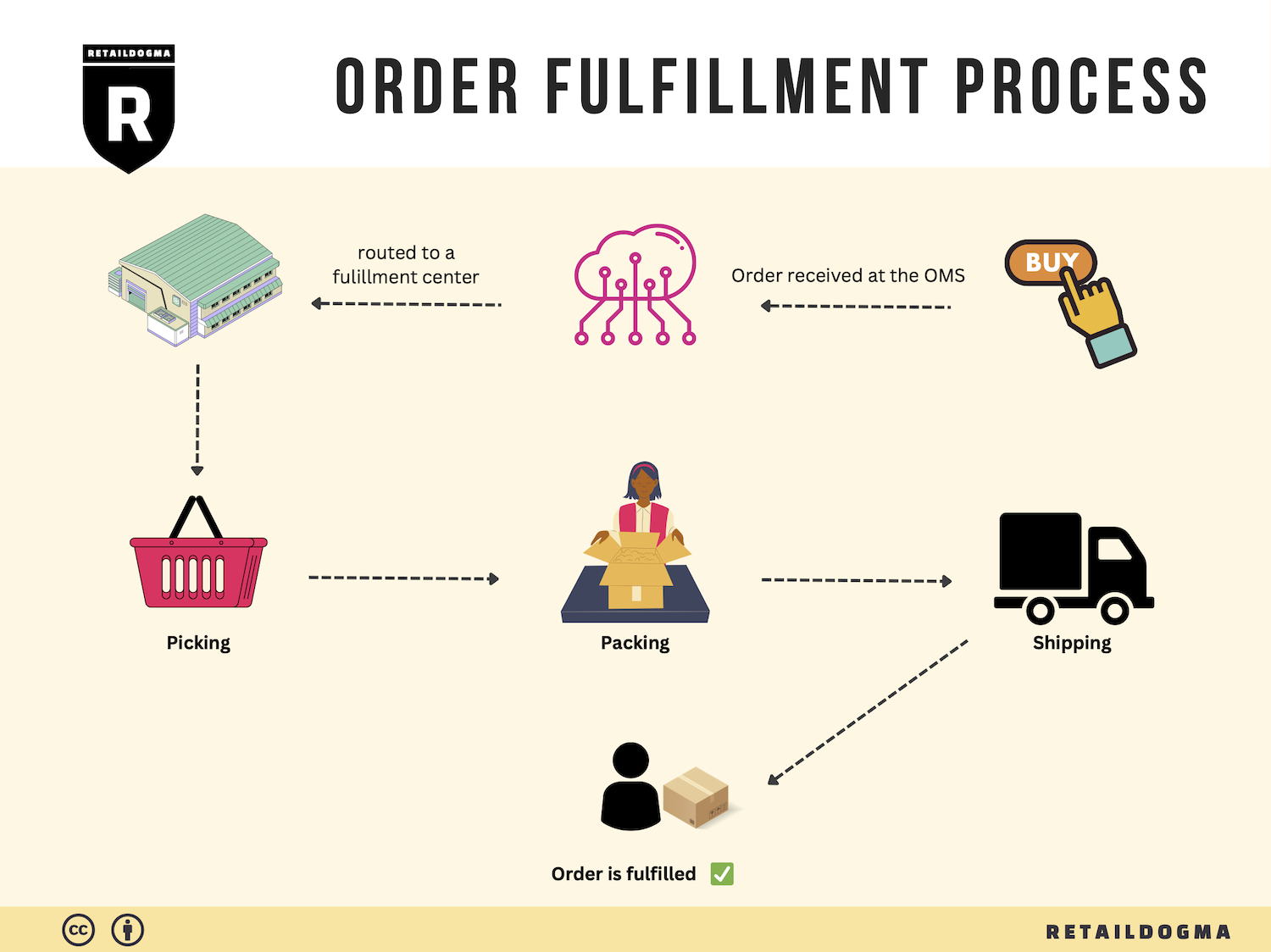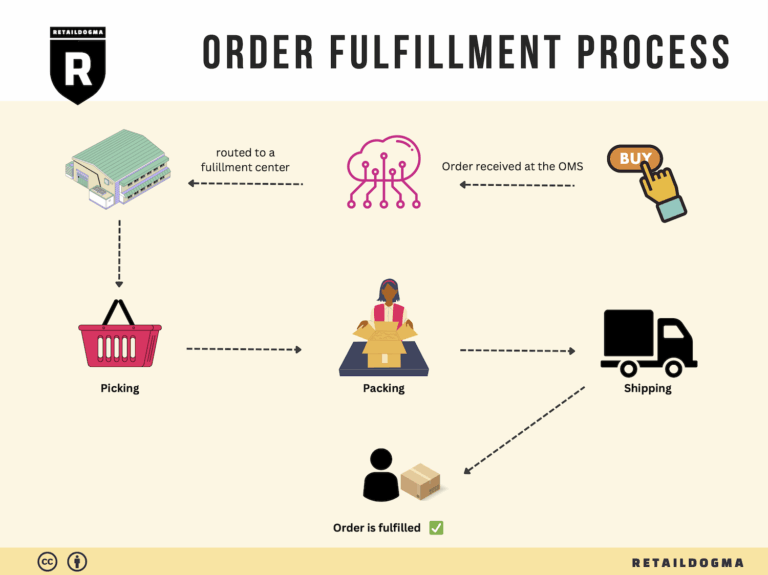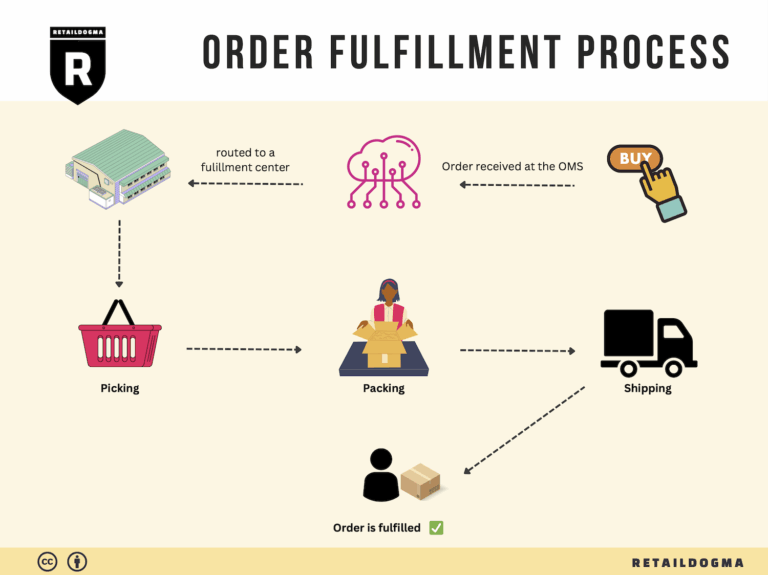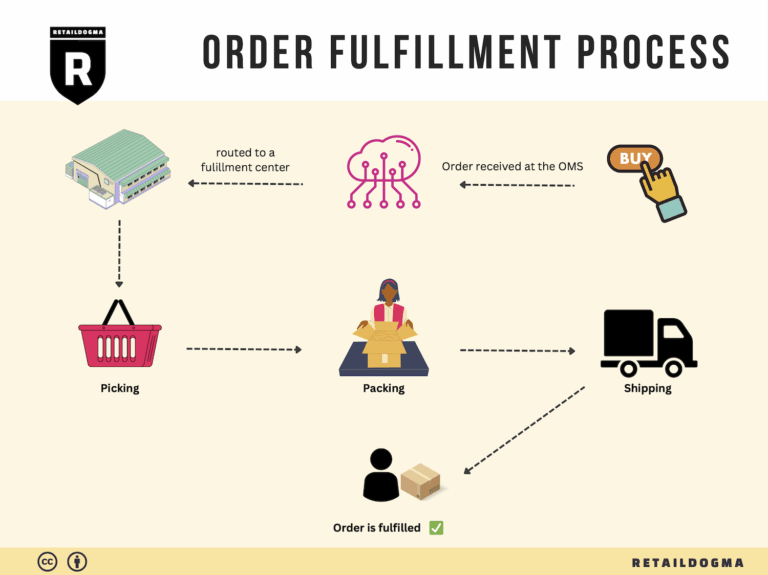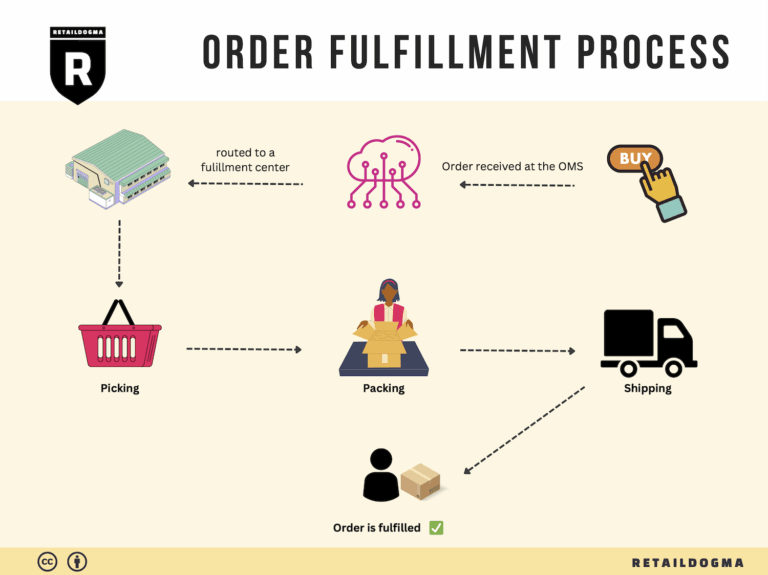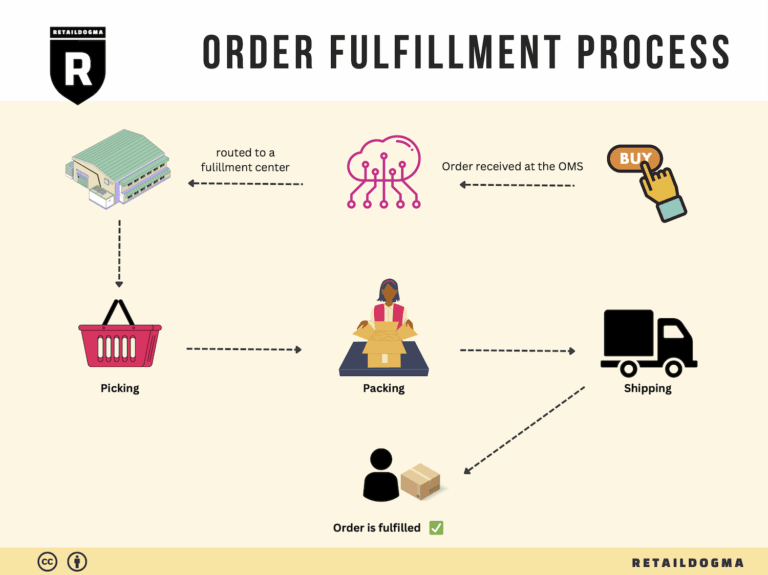Ecommerce Fulfillment Services: The Ultimate Guide (2025)
What is E-commerce Fulfillment? An Introduction for Growing Businesses
As e-commerce businesses scale, one of the most significant challenges they face is managing the overwhelming process of packing and shipping orders. Many entrepreneurs find themselves buried in boxes, packing materials, and shipping labels, often sacrificing valuable time that could be spent on growth strategies or customer engagement. This is where e-commerce fulfillment comes into play—a crucial process that involves getting products from your warehouse or supplier directly to your customers’ doorsteps.
Understanding E-commerce Fulfillment
At its core, fulfillment is the entire operation of receiving, processing, and delivering orders to customers. For growing businesses, effective fulfillment is more than just shipping; it encompasses inventory management, order processing, and customer service. As your business expands, the complexities of fulfillment can increase exponentially, making it vital to understand the various models and options available.
Key Fulfillment Models
In this guide, we will explore different fulfillment models that can cater to your business needs. One popular option is Third-Party Logistics (3PL), where businesses outsource their logistics operations to specialized firms. Another prevalent choice is Fulfillment by Amazon (FBA), which allows sellers to store their products in Amazon’s warehouses, leveraging their vast distribution network. Understanding these models will help you make informed decisions about which approach aligns with your business strategy.
Core Fulfillment Services
We will also delve into the core services that fulfillment partners typically offer, including warehousing, inventory management, order processing, packing, shipping, and returns management. Each service plays a critical role in ensuring a seamless customer experience and operational efficiency.
Choosing the Right Fulfillment Partner
Selecting the right fulfillment partner can be daunting. We will provide practical tips on what to look for in a partner, including technology integration, service offerings, scalability, and customer support. A suitable partner can significantly impact your logistics operations and, ultimately, your bottom line.
Pricing Considerations
Understanding pricing structures is essential for budgeting and financial planning. We will break down common pricing models, including per-order fees, storage fees, and shipping costs, helping you anticipate and manage expenses.
Empowering Smart Decisions
The ultimate goal of this guide is to empower you, the business owner, to make smart decisions about your logistics. By gaining clarity on the fulfillment process, exploring various models, and understanding the services and costs involved, you can streamline your operations and focus on what truly matters—growing your business and delighting your customers.
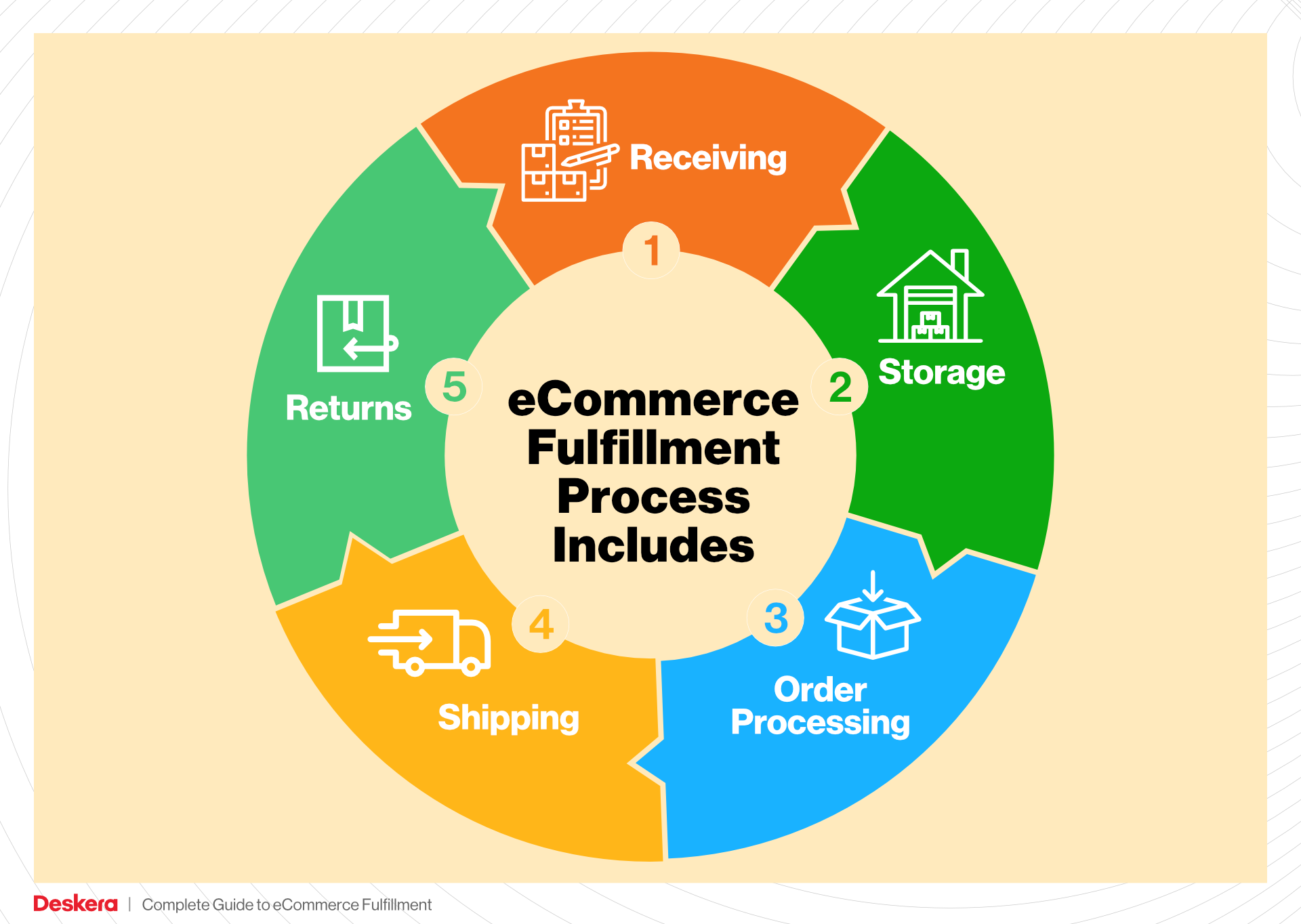
What You’ll Learn In This Guide
- What is E-commerce Fulfillment? An Introduction for Growing Businesses
- The Order Fulfillment Process: From ‘Buy’ Button to Customer’s Door
- Comparing Fulfillment Models: In-House vs. 3PL vs. Dropshipping
- A Deep Dive into Amazon FBA: Pros, Cons, and Who It’s For
- Core Services Offered by Fulfillment Centers
- How to Choose a Fulfillment Partner: A 6-Point Checklist
- Understanding Fulfillment Pricing: A Breakdown of Common Fees
- Frequently Asked Questions (FAQs) about Fulfillment
- Conclusion: Is Outsourcing Fulfillment the Right Move for Your Business?
- Important Disclaimer
The Order Fulfillment Process: From ‘Buy’ Button to Customer’s Door
1. Receiving Inventory
The order fulfillment process begins with receiving inventory. When products arrive at the Amazon Fulfillment Center, they are unloaded and checked against purchase orders to ensure that the right quantities and types of items have been delivered. Each product is assigned a Stock Keeping Unit (SKU), a unique identifier that helps track inventory levels and sales performance.
This step is crucial because it establishes the foundation of your inventory management system. Efficient receiving processes minimize errors and delays, ensuring that stock is available for immediate order fulfillment. Accurate inventory levels are essential for maintaining customer satisfaction; if stock is underreported, orders may be delayed or canceled, leading to negative experiences for customers.
2. Warehouse Storage
Once inventory is received, it is stored within the fulfillment center. Products are organized based on various strategies such as size, demand, or product type to optimize space and accessibility. The use of a Warehouse Management System (WMS) allows for real-time tracking of where each SKU is located within the facility.
Effective warehouse storage is vital for operational efficiency. A well-organized storage system reduces the time it takes to locate items during order picking. Moreover, by utilizing advanced storage solutions—like shelving, pallet racking, or automated storage systems—businesses can maximize their space and improve throughput. Proper storage management directly impacts order accuracy and the speed at which orders can be processed.
3. Order Picking
Once a customer places an order, the picking process begins. This involves selecting the right items from their storage locations to fulfill the order. Fulfillment centers often employ pick lists, which are documents that outline the items and quantities required for each order. In modern facilities, technology such as handheld scanners and automated picking systems may assist in this process.
Order picking is one of the most critical stages in fulfillment, as it directly affects order accuracy and speed. Efficient picking strategies, such as batch picking or zone picking, can significantly enhance productivity. The goal is to minimize the time spent locating and retrieving items, which ultimately leads to faster delivery times and improved customer satisfaction. Errors during this stage can lead to incorrect shipments, resulting in returns and customer dissatisfaction.
4. Order Packing
After items are picked, they are taken to the packing station, where they are prepared for shipment. During packing, products are carefully placed into boxes, and packing slips or invoices are included to inform customers of their purchase details. Packing materials, such as bubble wrap or packing peanuts, are used to protect items during transit.

The packing process is essential for ensuring that products arrive at their destination in good condition. Proper packing reduces the likelihood of damage during shipping, which can lead to costly returns and replacements. Additionally, packing efficiency impacts overall fulfillment speed; streamlined packing processes can significantly reduce the time between order placement and shipment. Businesses must also consider sustainability in their packing materials, as customers increasingly prefer eco-friendly options.
5. Shipping & Delivery
The final step in the fulfillment process is shipping and delivery. Once packages are packed, they are labeled and loaded onto delivery vehicles for transport to customers. Fulfillment centers like Amazon DET3 utilize a variety of shipping carriers and methods to ensure timely delivery, often providing customers with tracking information to monitor their shipments.
Shipping and delivery are pivotal in the customer experience. Timely delivery can enhance customer satisfaction and loyalty, while delays can lead to frustration and lost business. Businesses should continuously evaluate their shipping strategies, including carrier partnerships and delivery speed options, to meet customer expectations. Furthermore, offering various shipping options—like standard, expedited, or same-day delivery—can cater to different customer needs and preferences, ultimately driving sales and enhancing service levels.
In conclusion, understanding and optimizing each step of the order fulfillment process is crucial for e-commerce businesses looking to scale. By focusing on efficient receiving, storage, picking, packing, and shipping, businesses can improve operational efficiency, enhance customer satisfaction, and drive growth in a competitive market.
Comparing Fulfillment Models: In-House vs. 3PL vs. Dropshipping
Fulfillment Models Comparison
| Model | Who Handles Inventory | Best For (Business Stage) | Key Advantage | Key Disadvantage |
|---|---|---|---|---|
| In-House Fulfillment | The business itself | Established businesses with stable sales | Complete control over inventory and operations | High overhead costs and space requirements |
| Third-Party Logistics (3PL) | An external logistics provider | Growing businesses seeking scalability | Access to expertise and reduced logistics burden | Less control over inventory management and fulfillment speed |
| Dropshipping | Supplier or manufacturer | Startups and small businesses | Low initial investment and no inventory costs | Lower profit margins and potential supplier reliability issues |
In-House Fulfillment
In-house fulfillment refers to the practice where a business manages its entire inventory, warehousing, and shipping processes internally. This model is typically best suited for established businesses that have predictable sales patterns and enough capital to invest in the necessary infrastructure. The key advantage of in-house fulfillment is that it provides complete control over inventory and operations, allowing businesses to implement tailored processes that align with their specific requirements. This control can enhance customer satisfaction as businesses can directly manage order accuracy and delivery times.
However, in-house fulfillment comes with significant drawbacks. The overhead costs can be substantial, as businesses must invest in warehouse space, technology, and labor. Additionally, managing logistics internally can divert focus from core business activities such as product development and marketing. For businesses that experience fluctuations in demand or are in the early stages of growth, maintaining an in-house fulfillment operation can lead to inefficiencies and increased operational risks.
Third-Party Logistics (3PL)
Third-party logistics (3PL) involves outsourcing logistics and fulfillment operations to specialized providers. This model is ideal for growing businesses that are looking to scale without the burden of managing logistics themselves. By partnering with a 3PL, businesses can leverage the expertise and infrastructure of logistics providers, which can lead to faster shipping times, improved inventory management, and reduced operational costs.
The primary advantage of using a 3PL is the access to a vast network of resources and expertise, which allows businesses to focus on their core competencies while the 3PL handles logistics. This can be particularly beneficial during peak seasons or when entering new markets. However, the downside is that businesses may lose some control over their inventory management and fulfillment processes, which can impact customer experience. Additionally, the costs associated with 3PL services can vary significantly based on service levels and volume, making it essential for businesses to carefully evaluate potential partners to ensure they align with their operational goals.
Dropshipping
Dropshipping is a fulfillment model where the retailer does not keep products in stock but instead transfers customer orders and shipment details directly to the supplier, who then ships the products directly to the customer. This model is particularly attractive for startups and small businesses with limited capital and resources, as it requires minimal upfront investment in inventory.
The key advantage of dropshipping is that it eliminates the need for inventory management and warehousing, allowing entrepreneurs to test new products and markets without significant financial risk. This flexibility can be particularly advantageous for businesses in niche markets or those seeking to diversify their product offerings. However, dropshipping also presents challenges, including lower profit margins due to reliance on supplier pricing and potential issues with supplier reliability, which can affect order fulfillment times and customer satisfaction. Additionally, businesses have limited control over the quality of products and customer service, as these factors are largely dependent on the supplier’s operations.
Conclusion
Choosing the right fulfillment model is critical for e-commerce businesses looking to scale their operations effectively. In-house fulfillment offers control and customization but requires significant investment, while 3PL can provide scalability and efficiency at the cost of some control. Dropshipping minimizes risk and upfront investment but can lead to lower margins and quality concerns. Business owners must assess their specific needs, operational capabilities, and growth objectives to determine which fulfillment model aligns best with their strategic goals. By understanding the nuances of each model, e-commerce businesses can make informed decisions that drive efficiency and customer satisfaction as they scale.
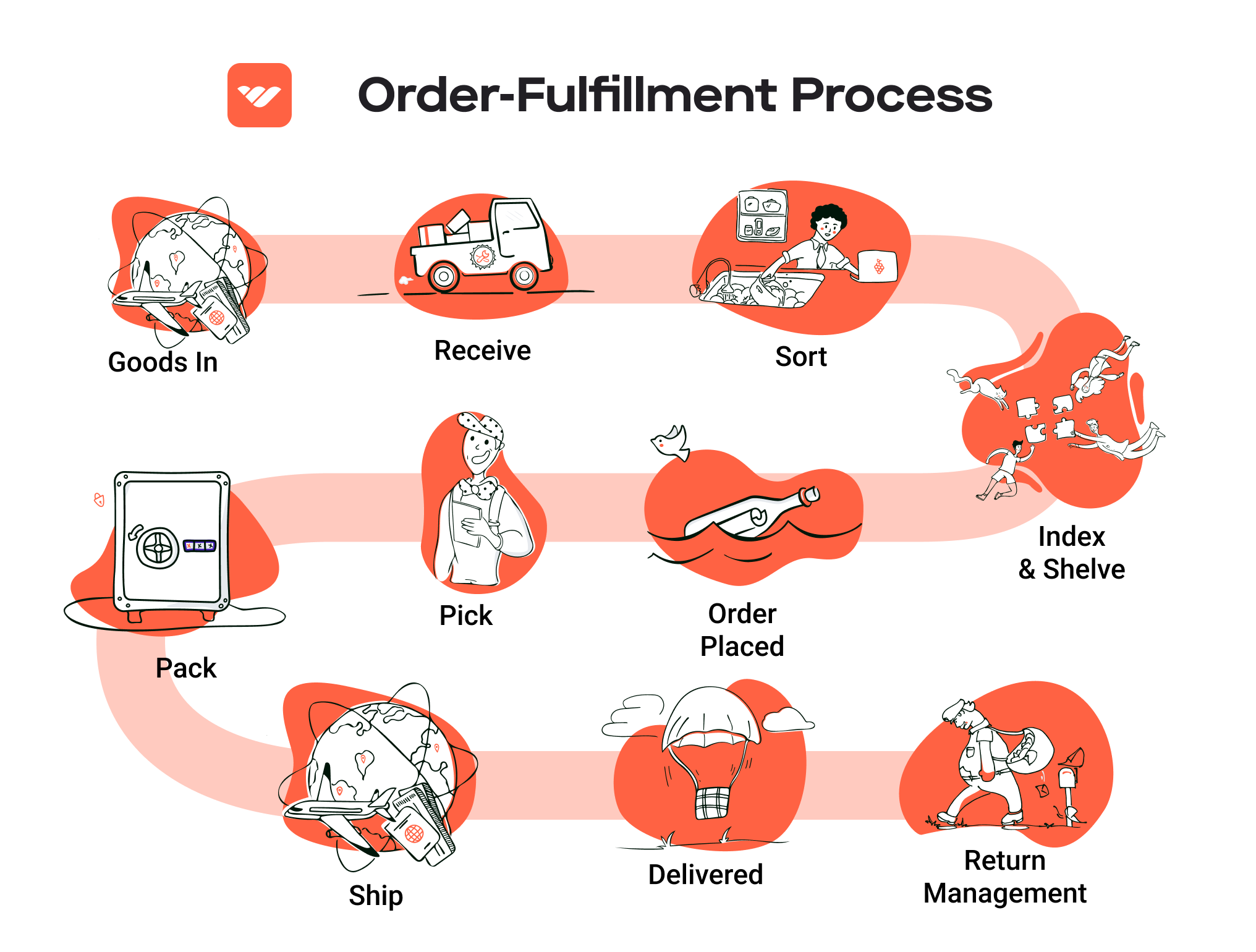
A Deep Dive into Amazon FBA: Pros, Cons, and Who It’s For
Understanding Fulfillment by Amazon (FBA)
Fulfillment by Amazon (FBA) is a service that allows e-commerce sellers to store their products in Amazon’s fulfillment centers. Amazon takes care of storage, packaging, and shipping of the products, allowing sellers to focus on other aspects of their business. This service is particularly beneficial for small to medium-sized businesses looking to scale their operations without investing heavily in logistics and warehousing.
How FBA Works
-
Setup and Storage: Sellers sign up for FBA through their Amazon Seller Central account. Once registered, they can create FBA shipments, sending their products to Amazon’s fulfillment centers, such as the DET3 center located in Pontiac, MI. The products are stored in Amazon’s warehouses until they are sold.
-
Order Processing: When a customer places an order, Amazon handles all aspects of the fulfillment process. This includes picking the product from the shelves, packing it, and shipping it to the customer, usually with the option for expedited shipping through Amazon Prime.
-
Customer Service and Returns: Amazon also provides customer service for FBA orders. This includes handling inquiries and managing returns, which simplifies the process for sellers and enhances the customer experience.
-
Multi-Channel Fulfillment: In addition to fulfilling orders from the Amazon marketplace, sellers can use FBA to fulfill orders from other sales channels, including their own websites or other online marketplaces. This flexibility allows businesses to streamline their logistics under a single fulfillment service.
Pros of Using FBA
-
Prime Eligibility: One of the standout benefits of FBA is the ability to offer products with Amazon Prime eligibility. This means that Prime members can receive free two-day shipping on your products, significantly increasing the likelihood of sales.
-
Customer Trust: Products fulfilled by Amazon come with the assurance of Amazon’s customer service and return policies. This trust can lead to higher conversion rates, as customers feel more confident purchasing items that are backed by a reputable company.
-
Multi-Channel Fulfillment: As mentioned, FBA allows businesses to fulfill orders not only from Amazon but also from other platforms. This capability can help businesses maintain consistency in shipping and inventory management across various sales channels.
-
Scalability: FBA provides an easy way to scale your business without the need for significant investment in warehousing and logistics. As your sales grow, Amazon can handle increased order volumes seamlessly.
-
Focus on Growth: With logistics managed by Amazon, sellers can focus on other critical areas of their business, such as marketing, product development, and customer engagement.
Cons of Using FBA
-
High Fees: One of the primary drawbacks of FBA is the cost. Sellers incur various fees, including storage fees for keeping products in Amazon’s warehouses and fulfillment fees for each order processed. These fees can add up quickly, particularly for products that have lower margins.
-
Strict Inventory Rules: Amazon has stringent inventory management policies that sellers must adhere to. This includes limits on the number of units that can be sent to fulfillment centers and strict guidelines on product preparation and labeling. Non-compliance can lead to additional fees or restrictions on selling.
-
Commingling Risks: FBA operates on a commingling model, where inventory from multiple sellers can be stored together. This can pose a risk, as sellers may receive returns or damaged items that do not belong to them, leading to potential losses and complications in inventory management.
-
Loss of Control: By outsourcing fulfillment to Amazon, sellers relinquish some control over the shipping process. This can lead to inconsistencies in packaging and handling, which might affect brand perception.
-
Dependency on Amazon: While FBA offers many advantages, it can create a dependency on Amazon as a primary sales channel. This reliance can be risky if Amazon changes its policies or algorithms, potentially impacting visibility and sales.
Who is FBA Best For?
Fulfillment by Amazon is particularly well-suited for:
-
Small to Medium-Sized Businesses: Companies that lack the resources to manage their own logistics can benefit greatly from FBA. It allows them to compete with larger retailers without the overhead costs of running a warehouse.
-
E-commerce Entrepreneurs: Those just starting in e-commerce can leverage FBA to simplify the fulfillment process, allowing them to focus on building their brand and marketing their products.
-
Sellers with High Sales Volume: Businesses that anticipate high sales volumes can maximize the benefits of FBA, as the fees can be offset by increased sales due to Prime eligibility and customer trust.
-
Multi-Channel Sellers: Brands that sell across different platforms can streamline operations and maintain consistent service levels through FBA, making it easier to manage logistics.
In conclusion, while FBA presents several advantages for scaling e-commerce operations, it is essential for sellers to weigh these benefits against the potential downsides. By understanding both the pros and cons, businesses can make informed decisions about whether FBA aligns with their growth strategies.
Core Services Offered by Fulfillment Centers
Inventory Management & Warehousing
Inventory management and warehousing are foundational services provided by fulfillment centers. This process involves the systematic control of stock, from receipt and storage to tracking and inventory counts. Fulfillment centers utilize advanced technologies, such as warehouse management systems (WMS), to optimize inventory levels and ensure accurate tracking.
Benefits:
1. Real-Time Inventory Tracking: E-commerce businesses benefit from real-time visibility into their stock levels, enabling them to make informed purchasing decisions and avoid stockouts or overstock situations.
2. Space Optimization: Fulfillment centers are designed to maximize storage efficiency, allowing businesses to store a larger quantity of products without needing to invest in additional warehouse space.
3. Scalability: As your business grows, fulfillment centers can easily accommodate increased inventory needs, ensuring that you can scale operations without the logistical headaches of managing your own warehouse.
4. Cost Savings: Outsourcing inventory management reduces overhead costs associated with staffing, equipment, and property maintenance, allowing businesses to allocate resources more efficiently.
Pick and Pack Services
Pick and pack services are essential for e-commerce operations. This process involves selecting (or “picking”) the right items from inventory and then packing them securely for shipment. Fulfillment centers employ skilled staff and automated systems to ensure accuracy and efficiency during this critical phase.
Benefits:
1. Accuracy and Speed: Professional pick and pack services reduce errors in order fulfillment, ensuring that customers receive the correct items promptly. This leads to improved customer satisfaction and repeat business.
2. Customized Packaging: Fulfillment centers can offer tailored packaging options that align with your brand’s identity, enhancing the unboxing experience for customers and contributing to brand loyalty.
3. Order Scalability: During peak seasons or promotional campaigns, fulfillment centers can easily scale up operations to handle increased order volumes without compromising service quality.
4. Time Efficiency: By outsourcing pick and pack operations, e-commerce businesses can focus on core activities such as marketing and product development, rather than being bogged down by logistics.
Kitting and Assembly
Kitting and assembly services involve grouping various products together into a single package or preparing items for sale in a ready-to-ship state. This service is particularly beneficial for businesses offering bundled products or promotional kits.
Benefits:
1. Enhanced Product Offerings: Kitting allows businesses to create attractive product bundles that can increase average order value and encourage upselling. For instance, a skincare company might bundle a cleanser, toner, and moisturizer into a single package.
2. Reduced Time to Market: By outsourcing kitting and assembly, businesses can streamline their production processes, reducing the time required to get products from concept to market.
3. Improved Inventory Management: Kitting helps in managing inventory more effectively by consolidating multiple SKUs into one, simplifying stock tracking and reducing the complexity of inventory management.
4. Cost Efficiency: Outsourcing these services minimizes the need for specialized labor and equipment, leading to significant cost savings while maintaining high-quality assembly standards.
Returns Management (Reverse Logistics)
Returns management, or reverse logistics, is the process of handling product returns efficiently. Fulfillment centers streamline this process by managing returned items, assessing their condition, and determining the best course of action—whether it’s restocking, refurbishing, or recycling.
Benefits:
1. Customer Satisfaction: Efficient returns management enhances customer satisfaction by providing a seamless return process. Customers appreciate hassle-free returns, which can lead to increased loyalty and repeat purchases.
2. Cost Reduction: By effectively managing returns, fulfillment centers help businesses minimize losses associated with unsellable inventory. They can quickly determine whether items can be restocked or need to be disposed of, reducing unnecessary costs.
3. Data Insights: Returns management provides valuable insights into customer behavior and product performance. Analyzing return data can help businesses identify trends, improve product quality, and adjust marketing strategies.
4. Reputation Management: A strong returns policy and efficient handling of returns can enhance a brand’s reputation, making it more appealing to potential customers who prioritize risk-free shopping experiences.
In summary, fulfillment centers offer a variety of core services that are essential for e-commerce businesses aiming to scale their operations effectively. By leveraging these services, businesses can enhance efficiency, reduce costs, and improve customer satisfaction, ultimately driving growth and success in the competitive online marketplace.
How to Choose a Fulfillment Partner: A 6-Point Checklist
Location & Warehouse Network
The geographical location of your fulfillment partner is crucial to ensure timely delivery and reduced shipping costs. A partner with a well-placed warehouse network can significantly improve your logistics efficiency.
Why It Matters:
Proximity to your customer base can lower shipping times and costs, enhancing customer satisfaction and loyalty. A partner with multiple locations can help in optimizing shipping routes and reducing transit times.
Questions to Ask:
– Where are your warehouses located, and how do they align with my target markets?
– What is your average shipping time to major destinations?
– Can you provide details on your network’s capabilities for domestic and international shipping?
Technology & Integrations
In today’s digital-first world, technology is a key differentiator among fulfillment partners. A robust technology platform can streamline your operations, from inventory management to order tracking.
Why It Matters:
Effective technology integration ensures real-time visibility into inventory levels, order statuses, and shipping details. This transparency can enhance decision-making and operational efficiency.
Questions to Ask:
– What type of warehouse management system (WMS) do you use, and how does it integrate with e-commerce platforms like Amazon?
– Can you provide real-time tracking for shipments and inventory?
– Are there APIs available for seamless integration with my existing systems?
Specializations (e.g., Cold Storage, Oversized Items)
Different products require different handling and storage conditions. It is essential to choose a fulfillment partner that can accommodate your specific product needs.
Why It Matters:
Specialized facilities, such as those for cold storage or oversized items, can ensure that your products are stored and shipped under optimal conditions, which can prevent damage and spoilage.
Questions to Ask:
– Do you have specialized facilities for my product type (e.g., temperature-controlled storage, handling of oversized items)?
– What measures are in place to ensure product safety and compliance with regulations?
– Can you handle returns and damaged products appropriately for my specific inventory?
Scalability & Capacity
As your business grows, your fulfillment partner must be able to grow with you. Scalability ensures that you can meet increasing demand without compromising service quality.
Why It Matters:
A partner that can quickly adjust to your changing needs helps maintain customer satisfaction during peak seasons or unexpected growth spurts.
Questions to Ask:
– How do you handle seasonal spikes in order volume?
– Can you provide examples of how you’ve scaled operations for other clients?
– What is the maximum capacity of your warehouses, and how flexible is that capacity?
Pricing and Contracts
Understanding the pricing structure and contract terms is essential to ensure that you can manage costs effectively while also receiving quality service.
Why It Matters:
Transparent pricing helps avoid unexpected costs and allows for better budgeting. Clear contract terms protect your interests and define the service level expectations.
Questions to Ask:
– What is your pricing model (e.g., per order, per item, flat fee)?
– Are there additional fees for services such as storage, pick and pack, or returns?
– Can you outline the terms of the contract, including any exit clauses or minimum volume commitments?
Customer Support & Reviews
The level of customer support can make or break your experience with a fulfillment partner. Responsive and knowledgeable support can help resolve issues quickly, minimizing disruptions to your operations.
Why It Matters:
Strong customer support ensures that you have access to assistance when you need it, which is critical for maintaining operational continuity.
Questions to Ask:
– What customer support options do you provide (e.g., phone, email, chat)?
– What are your support hours, and how quickly can I expect a response?
– Can you share customer testimonials or reviews that speak to your service quality?
Conclusion
Choosing the right fulfillment partner is a critical decision that can significantly impact your e-commerce operations. By carefully evaluating potential partners against this checklist, you can make informed decisions that align with your business goals and customer expectations. Remember, the right partner not only fulfills orders but also contributes to your overall success and growth in the competitive e-commerce landscape.
Understanding Fulfillment Pricing: A Breakdown of Common Fees
Initial Setup Fees
Initial setup fees are typically charged when you first establish your account with a fulfillment center. This fee can vary based on the provider but generally includes costs associated with onboarding your business to their system. This may involve setting up your inventory, configuring software integrations, and training staff on your specific needs.
The calculation of this fee often depends on the complexity of your inventory and the level of service you require. For example, if you have specialized products that need unique handling or if you require extensive software integration, expect higher setup fees. To manage these costs, ensure you have all necessary product information and documentation ready, which can streamline the setup process.
Receiving Fees
Receiving fees are charged for the process of checking in your inventory once it arrives at the fulfillment center. This includes unloading, inspecting, and sorting your products into the designated storage areas.
The calculation of receiving fees is generally based on the number of units received or the volume of the shipment. For instance, a fulfillment center may charge a flat fee per pallet or a variable fee based on the number of items handled. To minimize these costs, consider consolidating shipments and ensuring that your products are correctly labeled and packaged, which can speed up the receiving process.
Storage Fees (per pallet/bin)
Storage fees apply to the space your inventory occupies within the fulfillment center. This fee is typically calculated on a monthly basis and can be charged per pallet, bin, or cubic foot, depending on the facility’s pricing structure.
For example, if you are utilizing pallet storage, you may be charged a specific rate for each pallet stored. If you have smaller items that fit into bins, the fee may be calculated based on the number of bins used. To optimize storage costs, analyze your inventory turnover rates and consider adjusting your stock levels to avoid excess storage fees. Additionally, some fulfillment centers offer tiered pricing, where the more pallets you store, the lower the rate per pallet.
Pick & Pack Fees (per item/order)
Pick and pack fees are incurred each time an order is fulfilled. This fee covers the labor involved in picking the items from storage and packing them for shipment.
The calculation of pick and pack fees can vary by provider. Some may charge a flat fee per order plus an additional fee per item picked, while others may have a tiered pricing structure based on order volume. For example, a fulfillment center might charge $2.00 for the first item picked and $0.50 for each additional item. To reduce these fees, consider optimizing your order sizes and frequency; larger orders can lead to lower per-item costs. Additionally, using standardized packaging can streamline the packing process, further reducing labor costs.
Shipping Fees
Shipping fees encompass the costs associated with transporting your products to customers. This fee is influenced by various factors, including the shipping method chosen, the weight and dimensions of the package, and the destination.
Shipping fees can be calculated based on flat rates, weight-based pricing, or dimensional weight pricing, which considers the size of the package relative to its weight. Many fulfillment centers partner with major carriers, allowing you to benefit from discounted shipping rates. To effectively manage shipping costs, evaluate different shipping options and consider offering multiple shipping methods to customers. Additionally, leveraging technology to automate shipping label generation can help reduce errors and save time.
Tips for Getting an Accurate Quote
-
Clarify Your Needs: Before reaching out for a quote, have a clear understanding of your inventory, order volume, and specific requirements. This will help fulfillment centers provide you with a more accurate estimate.
-
Request Detailed Breakdowns: When obtaining quotes, ask for a detailed breakdown of all fees. This will help you understand how each charge is calculated and identify areas where you might save costs.
-
Compare Multiple Providers: Don’t settle for the first quote you receive. Compare multiple fulfillment centers to find the best pricing model that suits your business needs.
-
Negotiate Terms: Many fulfillment centers are open to negotiation, especially if you can guarantee a certain volume of business. Don’t hesitate to ask for better rates or more favorable terms.
-
Review Contracts Carefully: Before signing any agreements, ensure you fully understand the terms, especially regarding fees. Look for any hidden costs or conditions that could impact your pricing.
By being thorough and proactive in your approach, you can effectively manage fulfillment costs and optimize your e-commerce operations.
Frequently Asked Questions (FAQs) about Fulfillment
1. What is the Amazon Fulfillment Center DET3?
The Amazon Fulfillment Center DET3, located at 1220 Featherstone Rd, Pontiac, MI, is a state-of-the-art facility where Amazon processes and ships orders. It utilizes advanced technology, including robotics, to efficiently handle a large volume of products, ensuring quick delivery times for customers.
2. How does the fulfillment process at DET3 work?
At DET3, products are received, stored, and picked based on customer orders. Once an order is placed, items are quickly retrieved from the shelves by associates or robots, packed, and then shipped to the customer. This streamlined process helps maintain high efficiency and accuracy in order fulfillment.
3. What is the difference between a warehouse and a fulfillment center?
A warehouse primarily serves as a storage space for goods, while a fulfillment center is designed specifically to manage the order fulfillment process, including picking, packing, and shipping products directly to customers. Fulfillment centers focus on speed and efficiency to meet customer demands.
4. What is a 3PL (Third-Party Logistics)?
A 3PL provider is a company that offers outsourced logistics services, including warehousing, fulfillment, and transportation. Businesses often partner with 3PLs to streamline their supply chain operations, allowing them to focus on core competencies like product development and marketing.
5. How much do fulfillment services cost?
The cost of fulfillment services varies based on several factors, including order volume, storage space, and additional services such as packaging or returns management. Typically, fulfillment centers charge fees based on the number of orders processed, the storage space used, and any specific handling requirements.
6. What types of products can be fulfilled at DET3?
The DET3 fulfillment center can handle a wide range of products, from electronics to household items. However, certain restrictions apply to hazardous materials or items that require special handling. It’s essential to verify product eligibility with Amazon’s guidelines.
7. Can I visit the DET3 fulfillment center?
Yes, the DET3 fulfillment center offers in-person tours for interested parties. These tours provide insight into the fulfillment process and the technology used. It’s recommended to book in advance as spots may fill quickly, and specific dress codes and safety regulations apply.
8. How can I ensure my products are stored correctly in the fulfillment center?
To ensure proper storage of your products at DET3, provide clear guidelines regarding product specifications, handling instructions, and any special requirements. Amazon’s fulfillment team will work to accommodate your needs and ensure efficient storage and retrieval.
9. What is the return process for items fulfilled at DET3?
Returns for items fulfilled at DET3 follow Amazon’s standard return policy. Customers can initiate a return through their Amazon account, and the fulfillment center will manage the return process, including restocking and inventory updates.
10. How can I get started with using DET3 for my fulfillment needs?
To begin using the DET3 fulfillment center, you’ll need to register for Amazon’s Fulfillment by Amazon (FBA) program. This involves setting up your seller account, listing your products, and shipping your inventory to the fulfillment center. Once set up, Amazon will handle the rest, from storage to shipping.
Conclusion: Is Outsourcing Fulfillment the Right Move for Your Business?
Evaluating the Benefits of Outsourcing Fulfillment
Outsourcing your fulfillment operations can be a transformative decision for your e-commerce business. By leveraging a specialized fulfillment service, you can save valuable time and resources that would otherwise be spent managing logistics. This allows you to focus on core business functions, such as product development and marketing, ultimately driving growth.
One of the most significant advantages of partnering with a fulfillment center is scalability. As your business grows, so do your logistics needs. A fulfillment service can easily adapt to your changing order volumes, ensuring that you can meet customer demand without the overhead costs associated with expanding your own warehousing capabilities. This flexibility is particularly beneficial during peak seasons or promotional events when order volumes can fluctuate dramatically.
Moreover, fulfillment centers bring a wealth of expertise to the table. They utilize advanced technology and best practices to optimize inventory management, order processing, and shipping. This not only enhances operational efficiency but also improves customer satisfaction through faster and more reliable delivery.
However, the success of outsourcing your fulfillment hinges on choosing the right partner. It’s crucial to evaluate potential fulfillment providers based on their capabilities, reliability, and alignment with your business goals. A well-chosen partner can significantly accelerate your growth trajectory, while the wrong choice could lead to logistical nightmares and lost sales.
Next Steps for Your Business
To determine if outsourcing fulfillment is the right move for your business, start by conducting a thorough audit of your current shipping processes. Assess your order volumes, shipping times, and customer feedback. Consider whether your existing setup can handle future growth. By understanding your logistics landscape, you can make an informed decision on whether a fulfillment partner is the strategic next step for scaling your operations effectively.
Important Disclaimer
⚠️ Important Disclaimer
The information in this guide is for educational purposes. Fulfillment services, pricing, and platform features change frequently. Always conduct your own due diligence and consult with providers directly before making business decisions.
